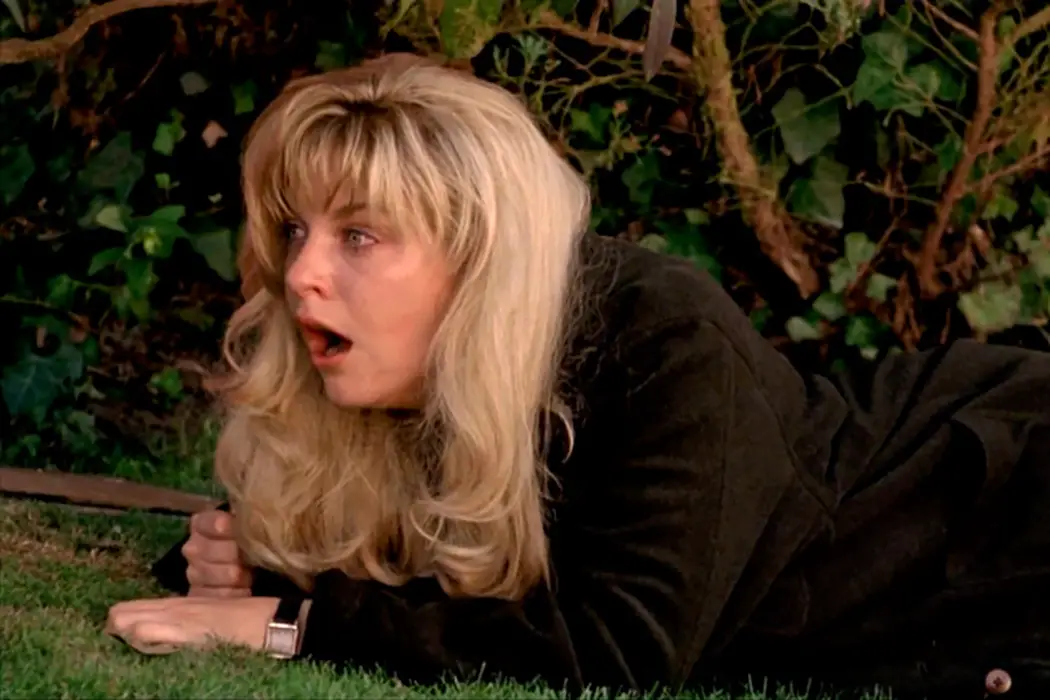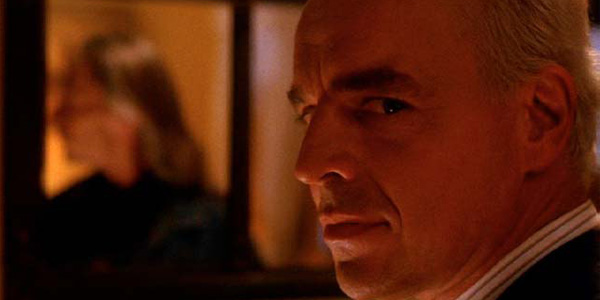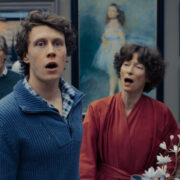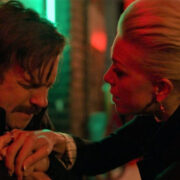The Excruciating Sadness Within TWIN PEAKS

Jack is a recent MA Graduate from the film department…
This article contains spoilers for Twin Peaks and Twin Peaks: Fire Walk With Me.
Oftentimes, it can be surprising how an individual reacts to certain media, certain visual provocation. Expertly put-together compositions of images can make us react in extraordinary ways, extremely surprising ways; this is a universal experience where everybody’s example is different. The sense of the experience, perhaps, is that it doesn’t have to make any sense at all – emotions can be stirred up through the simplest shot, the start of music, the briefest glance from an innocuous character.
In David Lynch and Mark Frost’s extraordinary original series, Twin Peaks, these provocative images are constant, overwhelming, explicit. What starts as a seemingly simple detective story revolving around the murder of a young high-school girl, becomes a tonally confusing, often supernatural take on the soap opera; the central mystery often takes a back-seat to the strange, murky lies of the various residents in the small town, many of whom are not as innocent as the setting would suggest. It is as much a comedy as a horror, juggling homely, quirky plot-points with the supernatural and the surrealistic, creating a fusion of genres and ideas that other shows have been trying to replicate ever since.
However many times I watch those early episodes of Twin Peaks, I find it an extremely distressing experience. It is not necessarily the surrealism of certain scenes that upset me, although the visit to the Red Room, with its otherworldly dialogue, strange clues and ‘arms bending back’ certainly has that visual provocation that I’ve already mentioned. It is actually, in a rather more understandable way, the scenes of grief, of crying and of screaming, that affect me so much in those early episodes, as we see an entire town have a breakdown at the loss of Laura Palmer, a loss that continues throughout all three seasons, twenty-six years of grief. The audience is forced to watch these prolonged, unbearably long scenes of crying, as the news ripples through the town; and when Laura’s mother sees visions, of demons and rings and gloved hands, her screams echo through your body.
Faces, Screaming, Crying in the original Twin Peaks series
It’s the faces of grief that resonate most in Twin Peaks.
To understand this, it may be as simple as to say that they resonate because we recognise them. In the outstanding collection of interviews of David Lynch, titled Lynch on Lynch, he is asked about the emotional outpouring seen in Twin Peaks, the prolonged horror of it, the way that the characters cry violently and the camera refuses to look away. He said in response to this that it is so effective a technique because the audience “know this feeling”, and once you recognise it, “you’re gone”.

In fact, the audience knows more than this feeling, the audience know that Laura Palmer is dead before her parents do, before her classmates do, before her boyfriend does. The dots get connected early on and what is so heartbreaking for us, the viewer, is that we see the characters have to slowly realise it themselves. When Leland Palmer is cheerily comforting his wife that Laura must be fine over the phone, the way that his face, his entire demeanour changes when he sees the policeman solemnly walk towards him is titanic in its power and its grief. It’s the same feeling and the same horror in the classroom, where Laura’s empty chair, coupled with the girl crying in the courtyard, lead Laura’s best-friends, Donna and James, to piece it together for themselves.
And to see them piece it together, right in front of you, is horrifying.
The Senseless Terror of BOB
The evil spirit known as BOB is the supreme antagonist of the series, the elusive figure of darkness who hides behind other people’s faces. The story goes that BOB was not in any way planned to be part of the series and that a series of happy accidents led to the set dresser for the original pilot, Frank Silva, being viewed by certain characters as visions, with a larger plan in mind for his role to grow in the series. Lynch clearly saw something in Silva, with his greasy grey hair and expressive face, that would perfectly lend itself to the series, and he was right, in a way.
BOB’s impact onto the series, his effectiveness into the heart of the viewer, actually diminishes as the show goes on. It is his early appearances, so unexplained, so random, that truly strike fear in their own bizarre way; his first appearance, behind the bedposts of Laura’s room, is so startling in its normality, the way BOB is just staring straight at the camera, emotionless expression, just watching. It is the lack of deliberate scare tactics in this moment, the fact he’s just there, that truly frightens, for it is so against the grain of horror, so unlike what we are accustomed too.

This is perhaps the only emotionless, still moment from Silva’s BOB however – Lynch fell in love with his twisting, morphing face, grinning and laughing and often howling, that runs towards us, the audience, a trick that Lynch has used more than once throughout his catalogue of films. BOB is often seen from a distance before reducing the distance quickly and dramatically, and Lynch makes the camera our eyes, we are his victim, he is coming towards us. There’s something wordlessly scary about BOB, perhaps only because Silva’s eyes look beyond the characters and the script and straight to us, the audience, an audience that believed they were safe from harm.
In the alternate ending to the original Twin Peaks pilot, BOB is caught in the act of murder and explains his motives and his mania, and Silva‘s performance dramatically suffers from having to actually talk, to have to converse with the other characters and strip away his own mystery. It is his silence, his eyes that see through the characters and straight into us, that makes BOB such a frighteningly effective, senselessly scary villain.
Sheryl Lee in Twin Peaks: Fire Walk With Me
Nobody is tormented by BOB more than Sheryl Lee’s Laura Palmer, the classical victim of the show’s overarching mystery, the basis for which every event in the show seems to revolve around. Sheryl Lee was cast quickly and almost in a hurry, as Frost and Lynch sought to put a face to the murder victim of the show; being dead, great acting talent was not necessary. Yet Lee was a once in a generation find, a true diamond in the rough, an actress who had to wait after the cancellation of this breakthrough series before being able to truly show her talents. It is in the prequel film, Twin Peaks: Fire Walk With Me, that Lynch gave her the true role of her life, building, complicating and ultimately destroying the innocent image of Laura Palmer, in material that truly explored the horrible depths that Twin Peaks the television show only dared to hint at.

It is, of course, the revelation that Laura Palmer’s father is also Laura Palmer’s murderer that forms the basis for the darkness that surrounds Fire Walk With Me and that surrounds Sheryl Lee’s performance, a performance defined by moments of uncontrollable grief and waves of suicidal thinking. It was a revelation that was famously forced out into the show’s narrative years before Frost and Lynch felt it was ready, all in the name of pursuing ratings, yet there is often a misconception that the decision to make Leland Palmer the killer was rushed through pressure, ill-thought through and ultimately unexplored. It is true that the show barely begins to explore the consequences or indeed the implications behind the narrative twist, presumably due to how horrifying those implications may be – yet Fire Walk With Me is unafraid to explore these dark corners, lift the veil covering the final few weeks of Laura Palmer’s life, and it is entirely on the shoulders of Sheryl Lee to help the audience comprehend this horror, this unsaid suggestion.
Behind the Veil of Family
So when Laura Palmer lies on the grass outside her house, having just had it revealed to her that her emotional abuser, her manipulator, her molester, has been her father the entire time, her shaking sobs of total horror and grief leave permanent shudders down your body. There is an absolute fear at work here, the fear of not being able to enter your own house, unable to trust your own parents, the guardians that nature appointed to look after you. This is the kind of material David Lynch thrives on, exploiting the primal fear at the heart of the American household, that at any moment the blissful and innocent figure of suburbia will turn around to bite you.
Lynch twists these family values, uproots the taboos, and displays them for everybody to see in Twin Peaks: Fire Walk With Me, and maybe that’s why the horror of Twin Peaks truly scares me. Behind the faces, the screaming faces of grief, behind BOB and Laura Palmer’s smiling face, hiding all the horrors in the world, lies the simple reality that Twin Peaks pushes towards us; that we may not be able to trust those around us, that the dream of suburbia and happiness that America sells may be a lie.
As Lynch says in Lynch on Lynch, we, the audience, know what grief is. We recognise the faces collapsing with the weight of news, the little suggestions around us before the blow is landed that not everything is right, that the world has shifted slightly in grief, in loss. We recognise the grief before the characters have even seen inside themselves and the power of most of Twin Peaks are those faces, so quickly broken under the tragedy of Laura Palmer’s death, a tragedy that of course surrounds the show. I talked at the beginning of this article that sometimes images can surprise you in how you yourself react to them; it may not make sense when you laugh, cry or tingle with horror as you watch. Yet perhaps Twin Peaks, in those strange close-ups of BOB, those crumpled faces of grief, makes absolute and total sense in the way that it sends shivers down my spine, makes me want to weep for me, for them.
Lynch is sometimes dismissed as a director of style over substance, an artist who prioritises the weird over the real – the core themes of Twin Peaks, those early scenes of grief and loss, could not be any more bathed in the harsh light of reality.
What kind of reaction did Twin Peaks have on you? Did Twin Peaks: The Return scare in the same ways? Let us know in the comments!
Does content like this matter to you?
Become a Member and support film journalism. Unlock access to all of Film Inquiry`s great articles. Join a community of like-minded readers who are passionate about cinema - get access to our private members Network, give back to independent filmmakers, and more.
Jack is a recent MA Graduate from the film department at the University of Southampton. He has been writing about film and football casually since 2013, considering himself as an expert on the works of Akira Kurosawa, Park Chan-wook and Steve McQueen ; less of an expert on every other important director.










